Pairing white wine with fish is a golden rule going back decades for anyone hosting a dinner party.
Those really looking to impress also know oysters must always be served with champagne.
But pairing food and drink is largely a marketing ploy, according to Professor Charles Spence, a psychologist and expert in the sensory qualities of food from the University of Oxford.
There is just as much reason to serve pilchards with champagne as oysters, he says, based on the theory that the seafoods contain the same amino acid which can boost their savoury ‘umami’ flavour in combination with a bottle of bubbly.
He has also questioned the popular suggestion that people should pair things from the same geographical region, like Spanish paella with Rioja, and beer with sauerkraut, because of a lack of evidence their flavours work particularly well together.


Those really looking to impress also know oysters must always be served with champagne. But pairing food and drink is largely a marketing ploy, according to Professor Charles Spence
People who like to talk about complementary molecules in food and drink overlook the fact that these molecules and amino acids often make very little difference to the actual flavour, according to the expert.
He says several red wines are perfectly fine to drink with fish, if their iron content is reasonably low.
The only possible reason to pair a certain wine with a certain food, in his view, is to enhance the fatty texture of meat by having a glass of red wine which feels more tingly in the mouth as it goes down.
In a scientific paper on food pairings, published in the journal Nature Food, Professor Spence writes: ‘On occasion, specific food and drink products are paired for no other reason than the idiosyncratic whimsy of the person who happens to be recommending the match in the first place.’
While pairing may be popular, he concludes: ‘It can be argued that our preference for specific foods, drinks and their combinations relies as much on trends, tradition, price and availability as it does on the underlying flavour chemistry.’
The academic told the Mail: ‘People like to have knowledge of food pairings, and it adds to their enjoyment of a meal, while perhaps allowing them to show off to their friends if they have prepared the magical combination of champagne and oysters or a particular wine with their cheese board.
‘But this is just storytelling about food, because the volatile chemicals in specific wines and food aren’t necessarily dominant when it comes to flavour.


There is just as much reason to serve pilchards with champagne as oysters, he says, based on the theory that the seafoods contain the same amino acid which can boost their savoury ‘umami’ flavour in combination with a bottle of bubbly
‘A pairing menu in a restaurant, with specific wines matched to different courses, is often more expensive, and I don’t think it wouldn’t make much difference if you switched the combinations around.’
The article on pairings says champagne and oysters may be put together simply because they are both now seen as ‘luxury’ and high-status items.
But consuming them together, according to some experts, leaves an unpleasant metallic taste in the mouth.
Pairing has become so popular that even beer companies have got in on the act, recommending various craft beers to be consumed with particular pizzas or burgers.
More sophisticated types opt to serve trout with watercress in the UK, because the banks of the chalk streams where fishing for trout took place would likely have also been home to watercress, growing in much the same conditions as the fish.
But Professor Spence argued in a previous paper from 2019 that: ‘At first blush, this match does not seem in any sense based on a perceptual affinity between the flavours found in trout and watercress from a flavour, or flavour pairing, perspective.
‘Rather, it would merely appear to be a match of convenience/availability that has become conventional, and hence increasingly familiar to those within the relevant food culture.’
Pairing wine with a cheese board, he says, is haphazard, because the cheeses have so many different flavours.
He told the Mail: ‘The only pairing which makes any sense to me in terms of flavour is to avoid drinking orange juice after brushing your teeth, because that goes very badly indeed with toothpaste.’
Celebrity chef Heston Blumenthal is well known for his love of unusual flavour pairings, like caviar and white chocolate, but he has suggested certain approaches to combining them do not work, telling the Times in 2010: ‘Looking back at my younger self I’m almost embarrassed at my bumptious enthusiasm, not least because I now know that a molecule database is neither a short cut to successful flavour combining nor a failsafe way of doing it.
‘Any foodstuff is made up of thousands of different molecules – that two ingredients have a compound in common is a slender justification for compatibility.
‘If I’d known then what I know now, I would probably never have tried this method of flavour pairing: there are simply too many reasons for it not to work.’







More Stories
New vaccine may hold key to preventing Alzheimer’s, scientists say
Just 1% of pathogens released from Earth’s melting ice may wreak havoc
Europe weather: How heatwaves could forever change summer holidays abroad